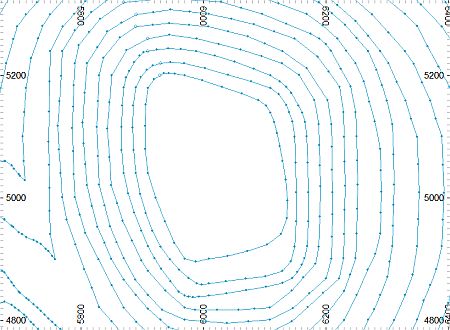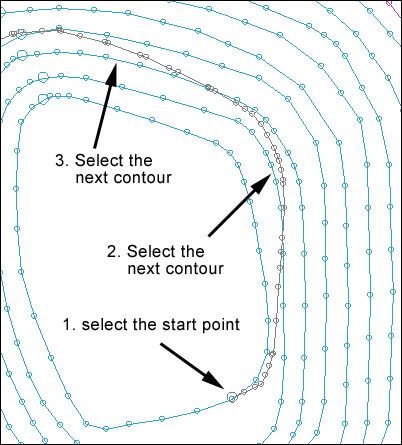|
|
Creating Ramp Strings Contours method: creating ramp design strings |
Overview
In this part of the tutorial you are going to create ramp strings between a set of pit toe contours.
|
The Contours design method involves inserting ramp and crest strings into an existing set of toe contour strings. These toe strings are typically created by generating contours around an optimum pit shell block mode at the bench toe position. |
Prerequisites
Required:
-
Created a new project and added all the required tutorial files i.e. the exercises on the Creating a New Project page.
-
Loaded and viewed the ultimate pit shell model data i.e. the exercises on the Viewing Ultimate Pit Shell Models page.
-
Created and applied a custom legend, filtered cells, for the NPVS block model i.e. the exercises on the Creating a Custom Display Legend page.
Recommended:
-
Specified project and mine design settings i.e. the exercises on the Specifying Design Settings page.
Files required for the exercises on this page:
-
_vb_c_toecons
Link to Exercises
The following exercises are available on this page:
Exercise: Creating Ramp Strings Between Contours
In this exercise you are going to use the bench toe contours _vb_c_toecons as a starting point for creating ramp design strings for the pit. This includes the following tasks:
-
Defining data and design plane settings
-
Saving to a new strings file
-
Creating the ramp design string
-
Saving the data.
Defining Data and Design Plane Settings
-
Select the Design window.
-
In the Project Files control bar, Strings folder, drag-and-drop the following file into the Design window:
-
_vb_c_toecons
-
-
In the Sheets control bar, Design Overlays folder, select only the following overlays (i.e. display these overlays):
-
Default Grid
-
_vb_c_toecons (strings)
-
-
In the View Control toolbar, click Zoom All Data.
-
In the View Control toolbar, click View Settings.
-
In the View Settings dialog, define the parameters shown below, click OK:

-
In the View Control toolbar, click Zoom In.
-
In the Design window, drag a zoom rectangle to display the view extents shown below:

Saving To a New Strings File
-
In the Loaded Data control bar, right-click on the _vb_c_toecons (strings) object, select Data | Save As.
- In the Save New 3D Object dialog, click Single Precision Datamine (.dm) File.
- In the Save New Strings dialog, select the path to your tutorial folder 'C:/Database/MyTutorials/OPDesign', define the File name: as 'c_pitrampds.dm', click Save.
- In the Loaded Data control bar, check that _vb_c_toecons (strings) has been replaced by c_pitrampds (strings).
- Check that c_pitrampds (strings) is the current strings object i.e. highlighted bold.
Creating the Ramp Design String
|
The ramp design string is created between pairs of toe contour strings and represents the path of the road. You can have as many separate ramp strings as you like. Often new ramp strings will need to be started where confined spaces may result in unrealistic or sharp turns/crossovers. Where such problems exit, place your roads on straight portions of the pit or where there are gentle curves. |
-
In the Design window, right-click and select Deselect All Strings (das).
-
Select Applications | Open Pit | Road Layout Tools | Road Between Contours (rbc).
-
In the Studio 3 dialog, define the Road Gradient % as '12', click OK.
-
Set the road gradient to 12 (percent) and clickOK.
-
Follow the messages displayed on the left side of the Status Bar for the following steps.
-
Using the image below as a guide, perform the next steps:

-
In the Design window, select (left-click) the start point of the ramp on the lowest toe string.
-
Select (left-click) the next (-20m elevation) toe contour string at a point which also defines the direction of the ramp string.
-
Repeat step 8 for each of the contours up to 100m elevation i.e. the last whole contour, click Cancel.

Use the keyboard arrow keys or Pan Graphics button to pan the view in between selecting the points for the ramp. If you make a mistake simply erase the string and re-run theRoad Between Contours(rbc) command.
-
Select the new ramp string.
-
Select Design | Edit Attributes | Edit (eat).
-
In the Edit Attributes dialog, select a COLOUR attribute value of [5], click OK.
-
In the Studio 3 confirmation dialog, click Yes.
-
In the Design window, right-click and select Deselect All Strings (das), check that your green ramp design string is a shown below:

-
Select Format | VR View | Update VR Objects (vro).
-
In the VR window, rotate, pan and zoom the view, noting the position of the ramp design string relative to the bench toe contours:


In this exercise, the ramp has been created using a single design string. It could also have been created using individual strings which start and end at successive toe contours or multiples of contours. The sequence of strings does not need to form a continuous ramp, but can be broken up into shorter sections of ramp, located in different parts of the pit. Switchbacks can also be constructed using this method.
Saving the Data
-
Select File | Save.
-
In the Save Data/Set Auto Reload dialog, select to Save the c_pitrampds (strings) object, click OK.
|
You can check your design strings against the example file _vb_c_pitrampds.dm. |
Copyright © CAE Inc.
MIN 20048_00_EN

